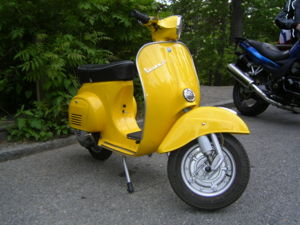Vespa 125 Primavera
| Vespa | |
|---|---|

|
|
| Vespa 125 Primavera | |
| Manufacturer | Piaggio |
| Production period | 1967 to 1982 |
| class | Scooter |
| Motor data | |
| air-cooled single cylinder two-stroke engine | |
| Displacement (cm³) | 121 |
| Power (kW / PS ) | 4.1 / 5.6 |
| Previous model | Vespa 50 |
| successor | Vespa PK |
The Vespa 125 Primavera and similar models are scooters from the manufacturer Piaggio , which sells its classic product line under the brand name Vespa .
History: 125 Nuova
In 1965, the Vespa 125 Nuova supplemented the smallframe series, which had been started two years earlier, with a 125 cm³ engine, with the addition of nuova serving to differentiate it from the Vespa 125 . The chassis of the Vespa 125 Nuova was based on that of the Vespa 50 : the jaws are an integral part of the self-supporting sheet steel frame, and the engine is only accessible via a flap, which is installed at an angle of 45 °. The Vespa 125 Nuova was built in around 17,000 units until 1967.
Successful model 125 Primavera
The Vespa 125 Primavera was presented in 1967 as a facelift of the Vespa 125 Nuova and developed into the most successful series with over 240,000 units built in 14 years of construction . Compared to the Vespa 125 Nuova, the frame of the Vespa 125 Primavera is slightly longer, but the leg shield and the footplate are narrower. It also has a luggage compartment in the left side cheek. The hexagonal Piaggio emblem is emblazoned above the cascade and the word "125 primavera" is located above the rear light . A total of three series were produced, the first with the taillight of the Vespa 90 SS and an italic "Vespa" lettering on the leg shield, the second from 1973 with a modern, straight lettering on the front and the third series from 1976 parallel to the Vespa 125 Primavera ET3 . Production ended in 1982. The motorization was provided by a 121 cm³ engine with 5.6 hp. Originally there were two colors, Biancospino (hawthorn white) with a black bench and later also Marrone metallizzato (brown metallic) with a cream-colored bench.
Successor ET3
In 1976, the Vespa 125 Primavera ET3 expanded the very popular Vespa 125 Primavera , which was sold on, and looks little different from it. The name was given by the newly introduced electronic ignition and the third transfer channel (ET3 stands for Elettronica Travasi 3), the visible distinguishing feature was the new exhaust, which was led around the engine in a banana shape ("ET3-Banana"). All these measures also led to a slightly higher engine output (approx. 90 km / h). The Vespa 125 Primavera ET3 was delivered in numerous colors. In 1983 production ended after 144,000 vehicles had been built.
Technical specifications
| 125 Nuova | 125 Primavera | 125 Primavera ET3 | PK 125 (comparison) | |
|---|---|---|---|---|
| construction time | 1965-1967 | 1967-1982 | 1976-1983 | 1983-1990 |
| Frame number prefix | VMA1T | VMA2T | VMB1T | VMX5T |
| Engine type | Two-stroke single cylinder | |||
| Mixture preparation | Carburetor | |||
| Displacement | 121 cm³ | |||
| Bore × stroke (mm) | 55 × 51 | |||
| Max. Power (PS) at 1 / min |
4.8 4500 |
5.56 5500 |
7.0 5500 |
6.8 5600 |
| Top speed | 75 km / h | 80 km / h | 85 km / h | 86 km / h |

